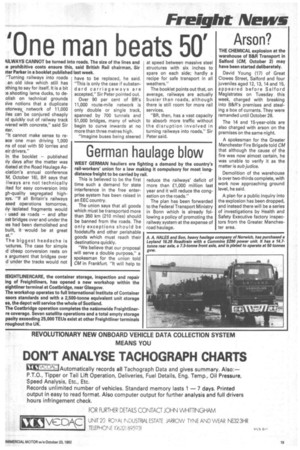'One man beats 50'
Page 9

If you've noticed an error in this article please click here to report it so we can fix it.
4ILWAYS CANNOT be turned into roads. The size of the lines and le prohibitive costs ensure this, said British Rail chairman, Sir ?ter Parker in a booklet published last week.
"It cannot make sense to reace one man driving 1,000 ns of coal with 50lorries and eir drivers."
In the booklet — published ily days after the matter was ;bated at the Road Haulage Asciation's annual conference 'M, October 16), BR says that ilways are not technically ited for easy conversion into gh-quality segregated high3ys. "If all Britain's railways ased operations tomorrow, ily isolated fragments would
used as roads — and after ost bridges over and under the les had been demolished and built, it would be at great
The biggest headache is -uctures. The case for simple d cheap conversion rests on a argument that bridges over d under the tracks would not
"This is only the case if substandard carriageways are accepted," Sir Peter pointed out.
Over 90 per cent of BR's 11,000 route-mile network is only double or single track, spanned by 700 tunnels and 51,000 bridges, many of which begin to curve inwards at no more than three metres high.
"Imagine buses being steered at speed between massive steel structures with six inches to spare on each side; hardly a recipe for safe transport in all weathers."
The booklet points out that, on average, railways are actually busier than roads, although there is still room for more rail services.
"BR, then, has a vast capacity to absorb more traffic without the disruption involved in turning railways into roads," Sir Peter said.


















































































































